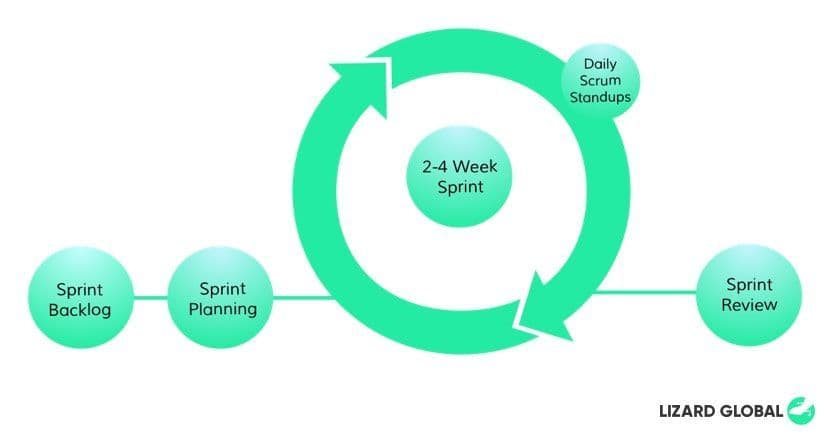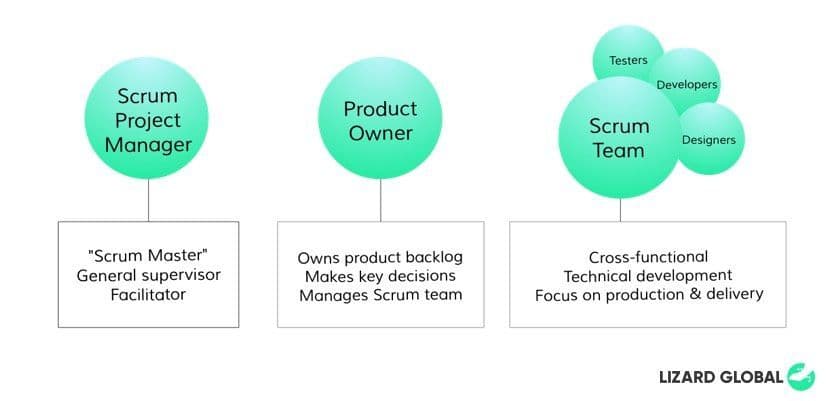agile
scrum methodologies
+ 5 more ...
The Scrum Sprint Up Close: What, Who, How?
08 May 2020
by Lotte, Digital Content Specialist
08 May 2020
by Lotte, Digital Content Specialist
agile
scrum methodologies
sprint
iterative prototyping
app development
scrum master
product owner
The Scrum Sprint Up Close: What, Who, How?
Table of contents
Contact us
We will get back to you in the next 48 hours.

Scrum Sprints are indispensable when it comes to working Agile at a Lean Startup. But how exactly do they work? And who is involved in this process?
As a Lean Startup working Agile, Scrum Sprints are indispensable. In our blog about Agile methodologies we already introduced you to the phenomenon of Scrum Sprints. This blog dives deeper into the process of Scrum Sprints, how they are structured, the different roles, and how these Sprints can bring your business processes to the next level.
The birth of Scrum
The first notions of Scrum trace back from the year 1986, when the term got introduced in the context of product development in a Harvard Business Review article. Scrum was described as a brand new approach for commercial product development, focussing on the increase of speed and flexibility of the development process. A cross-functional team would be responsible for the entire production process, divided over overlapping and iterative phases. The name “Scrum” refers to the formation of a rugby team when they restart play.
The Scrum approach became internationally popular from the year 2002,
with the founding of the so-called Scrum Alliance, and Scrum.org in late 2009. Scrum is now seen as a leading Agile development methodology, used by the biggest companies and Lean Startups around the world. Although Scrum is usually formulated as a methodology for Agile software development, it works well for any kind of complex project, software-related or not. However, the methodology serves merely as a guideline. Being pragmatic is, therefore, crucial and the actual process adoption depends highly on your organizational strategy, internal culture and offered services.
Scrum sprints: all you need to know
Scrum can be defined as a framework that improves the interaction and production processes within a software development team. Due to the iterative nature of the Sprints, Scrum encourages the team to learn from its experiences, constantly adapt and self-organise while creating solutions, and reflect on its mistakes and successes in order to constantly improve their game. It promotes an Agile production process, based on a continuous and iterative process of idea conceptualisation, experimenting, testing, and the implementation of end-user feedback.
The roles
In order to enable maximum Agility of your Scrum team, it’s important to not involve too many players, as it risks the process becoming chaotic, complex, and ultimately ineffective. An ideal Scrum team consists of five to six people, divided over three main roles:
The Product Owner The Product Owner (PO) can be seen as the executive and key stakeholder. A PO has a clear understanding of a product’s business context and strategic goals. By constantly acting upon market developments, a PO manages the dynamic Product Roadmap which represents the long-term vision of digital solution. It is crucial that a PO creates and maintains a shared understanding between all stakeholders involved.
The Scrum Project Manager Also known as Scrum Master, the Project Manager (PM) plans and organizes the entire Scrum process. By coordinating the Sprints, the PM supervises the entire Scrum team, including the Product Owner, and gives feedback and guidance when needed. They oversee everyday functions and development, maintain the Scrum board, and check in with their team members to make sure all processes are on schedule and focused on the main objectives.
The Scrum Team Members During a sprint, the Scrum Team is fully focused on the product increment that needs to be delivered at the end of the two weeks period. The members work closely together due to the complex task interdepencies: from front- and back-end developers to copywriters, UI/UX designers, and other departments of a full stack digital agency. Because team members have such varied roles in the process, it’s of great importance that they are fully aligned and aware of each other’s tasks and responsibilities in order to get the best output possible.. Only when the team is perfectly balanced and fully aware of the functions of their fellow team members, a Scrum Sprint can reach top level agility and produce high-end quality products.

The process
A Scrum Sprint is a recurring period of iterative work, focused on developing a product in the most Agile, cost-effective, and efficient way possible. Generally, a sprint lasts two weeks. Due to its iterative nature, agile Sprints allow you to evaluate your product after every incremental delivery. This facilitates a more flexible way of developing your product and gives you the possibility to validate your decision with your end-users to establish the ultimate product-market fit. A Scrum Sprint cycle typically consists of the following iterative phases:
Sprint Backlog
The Sprint Backlog are all Product Backlog items that will be processed within a specific Sprint and are ordered based on priority vs. complexity. The goal is to focus on delivering a product increment. The most important items of a Backlog are shown on top of the list, so the team members know where to start and what features to deliver first.
Sprint Planning
The Sprint Planning consists of five elements all Scrum Sprint members have to consider before beginning the sprint:
What: The Product Owner defines the main objectives of the sprint by closely interacting with all stakeholders, and decides what items have a priority position in the Product Backlog.
How: The Product Owner and Team Members negotiate about possible solutions in a limited time-span of the sprint, and what tools and knowledge are required to meet the priority goals of the sprint.
Who: The Scrum Team and their individual functions are put together, while keeping in mind this team has the necessary qualifications to closely collaborate with one another.
Inputs: The Sprint Backlog with all the information about the product increment is presented to the entire Team, which uses the input to finalize the process of their Sprint Planning.
Deliverables: With all the information gathered, the team sets an end-goal of the sprint and precisely specifies the steps they will take in order to achieve that end-goal at the end of the sprint.
Daily Scrum Standups
The execution of a Scrum Sprint consists of daily meetings of no more than 15 minutes, to make sure that every Sprint member is up-to-date with the execution of their tasks, all bottlenecks that stand in the way of progress and achieving the deadline are identified in an early stage. It’s a moment for the Team Members (developers, designers, etc.) to synchronise their activities and create a micro-planning for the next 24 hours. Daily Standups can be seen as very small sprints, working up towards the completion of a full Scrum Sprint. The Daily Scrum is preferably held at the time time and place every day, to keep a sense of consistency and avoid complexity.
Sprint Review/Retrospective
The Sprint Review is an informal meeting held at the end of a Sprint to validate the Shippable Product Increment, which is the complete collection of all Product Backlog items that are completed during the Sprint. After the completion of a Sprint, the new Increment must comply with what the entire team has defined as “Done” - often referred to as the “Definition of Done”. To make sure everyone is on the same page regarding the Definition of Done, the entire team decides upon the necessary criteria for a deliverable to be “Done” before the Sprint starts. A product that is defined as “Done” doesn’t necessarily mean the product will be launched on the market, as this is highly dependent on factors such as milestone planning and marketing efforts.
Next to reviewing the product increment, the Team Members will review communication between each other and key stakeholders, the tools they used, and the overall smoothness of the process. They identify major bottlenecks and come up with solutions to avoid these problems during the execution of the next Sprints. A Sprint Review typically consists of the following elements:
- All Team Members (Product Owner, Scrum Project Manager, UI/UX Specialist and Developers) kick off the meeting
- The Development team demonstrates (showcases) the Product Increment and answers questions about the Increment
- The Development Team discusses their experience of the Sprint, what went well, what bottlenecks they encountered, and how they solved these problems along the way
- The Product Owner provides input regarding the deliverables of the next sprint based on the outcomes of the Sprint Review, combined with the remaining items of the Product Backlog. All attendees collectively brainstorm on what to do next, in order to create a Review that provides valuable input for the next Sprint Planning
- The attendees review the current state of the marketplace and potential users, and if the product needs to be adjusted based on changes on the market or among end-users
- To close off, the attendees review the timeline, budget, functionalities, and marketplace to get insight into necessary implementation for future releases of the product

To survive a Sprint
Because Scrum Sprints are focused on working as Agile as possible, the process can be quite intense for everyone involved. After all, there is a lot of work that needs to be done in a very short period of time. In order to keep all members on track, the whole process needs to be streamlined in detail. Keep the following things in mind before and during your sprint:
- Is this your first Scrum Sprint? If so, make sure that the entire team is aware of the rules and methodologies involved in a Sprint. It might be a good idea to go through a “test Sprint” before starting the real deal.
- Make sure that your Scrum Sprints always last the same amount of time, with the same rules, and preferably the same team. Only with experience by repetition, with as little change as possible, can you achieve an optimized Sprint.
- Try to avoid interruptions as much as possible. Any break or disturbance negatively impacts the agility of a Sprint, and causes delays or a decrease in quality of the delivered product.
- Although a quick and agile process is essential, make sure that this newfound velocity doesn’t lower the quality of your product.
Lizard Global works Agile
At Lizard Global, we work with the mentality of a Lean Startup, and Scrum Sprints form an essential part of our methodology to achieve an Agile way of working. Do you need help with the Agile transformation of your company? Please reach out and we can help with the first steps based on a result-driven approach.

Scrum Sprints are indispensable when it comes to working Agile at a Lean Startup. But how exactly do they work? And who is involved in this process?
As a Lean Startup working Agile, Scrum Sprints are indispensable. In our blog about Agile methodologies we already introduced you to the phenomenon of Scrum Sprints. This blog dives deeper into the process of Scrum Sprints, how they are structured, the different roles, and how these Sprints can bring your business processes to the next level.
The birth of Scrum
The first notions of Scrum trace back from the year 1986, when the term got introduced in the context of product development in a Harvard Business Review article. Scrum was described as a brand new approach for commercial product development, focussing on the increase of speed and flexibility of the development process. A cross-functional team would be responsible for the entire production process, divided over overlapping and iterative phases. The name “Scrum” refers to the formation of a rugby team when they restart play.
The Scrum approach became internationally popular from the year 2002,
with the founding of the so-called Scrum Alliance, and Scrum.org in late 2009. Scrum is now seen as a leading Agile development methodology, used by the biggest companies and Lean Startups around the world. Although Scrum is usually formulated as a methodology for Agile software development, it works well for any kind of complex project, software-related or not. However, the methodology serves merely as a guideline. Being pragmatic is, therefore, crucial and the actual process adoption depends highly on your organizational strategy, internal culture and offered services.
Scrum sprints: all you need to know
Scrum can be defined as a framework that improves the interaction and production processes within a software development team. Due to the iterative nature of the Sprints, Scrum encourages the team to learn from its experiences, constantly adapt and self-organise while creating solutions, and reflect on its mistakes and successes in order to constantly improve their game. It promotes an Agile production process, based on a continuous and iterative process of idea conceptualisation, experimenting, testing, and the implementation of end-user feedback.
The roles
In order to enable maximum Agility of your Scrum team, it’s important to not involve too many players, as it risks the process becoming chaotic, complex, and ultimately ineffective. An ideal Scrum team consists of five to six people, divided over three main roles:
The Product Owner The Product Owner (PO) can be seen as the executive and key stakeholder. A PO has a clear understanding of a product’s business context and strategic goals. By constantly acting upon market developments, a PO manages the dynamic Product Roadmap which represents the long-term vision of digital solution. It is crucial that a PO creates and maintains a shared understanding between all stakeholders involved.
The Scrum Project Manager Also known as Scrum Master, the Project Manager (PM) plans and organizes the entire Scrum process. By coordinating the Sprints, the PM supervises the entire Scrum team, including the Product Owner, and gives feedback and guidance when needed. They oversee everyday functions and development, maintain the Scrum board, and check in with their team members to make sure all processes are on schedule and focused on the main objectives.
The Scrum Team Members During a sprint, the Scrum Team is fully focused on the product increment that needs to be delivered at the end of the two weeks period. The members work closely together due to the complex task interdepencies: from front- and back-end developers to copywriters, UI/UX designers, and other departments of a full stack digital agency. Because team members have such varied roles in the process, it’s of great importance that they are fully aligned and aware of each other’s tasks and responsibilities in order to get the best output possible.. Only when the team is perfectly balanced and fully aware of the functions of their fellow team members, a Scrum Sprint can reach top level agility and produce high-end quality products.

The process
A Scrum Sprint is a recurring period of iterative work, focused on developing a product in the most Agile, cost-effective, and efficient way possible. Generally, a sprint lasts two weeks. Due to its iterative nature, agile Sprints allow you to evaluate your product after every incremental delivery. This facilitates a more flexible way of developing your product and gives you the possibility to validate your decision with your end-users to establish the ultimate product-market fit. A Scrum Sprint cycle typically consists of the following iterative phases:
Sprint Backlog
The Sprint Backlog are all Product Backlog items that will be processed within a specific Sprint and are ordered based on priority vs. complexity. The goal is to focus on delivering a product increment. The most important items of a Backlog are shown on top of the list, so the team members know where to start and what features to deliver first.
Sprint Planning
The Sprint Planning consists of five elements all Scrum Sprint members have to consider before beginning the sprint:
What: The Product Owner defines the main objectives of the sprint by closely interacting with all stakeholders, and decides what items have a priority position in the Product Backlog.
How: The Product Owner and Team Members negotiate about possible solutions in a limited time-span of the sprint, and what tools and knowledge are required to meet the priority goals of the sprint.
Who: The Scrum Team and their individual functions are put together, while keeping in mind this team has the necessary qualifications to closely collaborate with one another.
Inputs: The Sprint Backlog with all the information about the product increment is presented to the entire Team, which uses the input to finalize the process of their Sprint Planning.
Deliverables: With all the information gathered, the team sets an end-goal of the sprint and precisely specifies the steps they will take in order to achieve that end-goal at the end of the sprint.
Daily Scrum Standups
The execution of a Scrum Sprint consists of daily meetings of no more than 15 minutes, to make sure that every Sprint member is up-to-date with the execution of their tasks, all bottlenecks that stand in the way of progress and achieving the deadline are identified in an early stage. It’s a moment for the Team Members (developers, designers, etc.) to synchronise their activities and create a micro-planning for the next 24 hours. Daily Standups can be seen as very small sprints, working up towards the completion of a full Scrum Sprint. The Daily Scrum is preferably held at the time time and place every day, to keep a sense of consistency and avoid complexity.
Sprint Review/Retrospective
The Sprint Review is an informal meeting held at the end of a Sprint to validate the Shippable Product Increment, which is the complete collection of all Product Backlog items that are completed during the Sprint. After the completion of a Sprint, the new Increment must comply with what the entire team has defined as “Done” - often referred to as the “Definition of Done”. To make sure everyone is on the same page regarding the Definition of Done, the entire team decides upon the necessary criteria for a deliverable to be “Done” before the Sprint starts. A product that is defined as “Done” doesn’t necessarily mean the product will be launched on the market, as this is highly dependent on factors such as milestone planning and marketing efforts.
Next to reviewing the product increment, the Team Members will review communication between each other and key stakeholders, the tools they used, and the overall smoothness of the process. They identify major bottlenecks and come up with solutions to avoid these problems during the execution of the next Sprints. A Sprint Review typically consists of the following elements:
- All Team Members (Product Owner, Scrum Project Manager, UI/UX Specialist and Developers) kick off the meeting
- The Development team demonstrates (showcases) the Product Increment and answers questions about the Increment
- The Development Team discusses their experience of the Sprint, what went well, what bottlenecks they encountered, and how they solved these problems along the way
- The Product Owner provides input regarding the deliverables of the next sprint based on the outcomes of the Sprint Review, combined with the remaining items of the Product Backlog. All attendees collectively brainstorm on what to do next, in order to create a Review that provides valuable input for the next Sprint Planning
- The attendees review the current state of the marketplace and potential users, and if the product needs to be adjusted based on changes on the market or among end-users
- To close off, the attendees review the timeline, budget, functionalities, and marketplace to get insight into necessary implementation for future releases of the product

To survive a Sprint
Because Scrum Sprints are focused on working as Agile as possible, the process can be quite intense for everyone involved. After all, there is a lot of work that needs to be done in a very short period of time. In order to keep all members on track, the whole process needs to be streamlined in detail. Keep the following things in mind before and during your sprint:
- Is this your first Scrum Sprint? If so, make sure that the entire team is aware of the rules and methodologies involved in a Sprint. It might be a good idea to go through a “test Sprint” before starting the real deal.
- Make sure that your Scrum Sprints always last the same amount of time, with the same rules, and preferably the same team. Only with experience by repetition, with as little change as possible, can you achieve an optimized Sprint.
- Try to avoid interruptions as much as possible. Any break or disturbance negatively impacts the agility of a Sprint, and causes delays or a decrease in quality of the delivered product.
- Although a quick and agile process is essential, make sure that this newfound velocity doesn’t lower the quality of your product.
Lizard Global works Agile
At Lizard Global, we work with the mentality of a Lean Startup, and Scrum Sprints form an essential part of our methodology to achieve an Agile way of working. Do you need help with the Agile transformation of your company? Please reach out and we can help with the first steps based on a result-driven approach.







